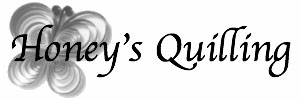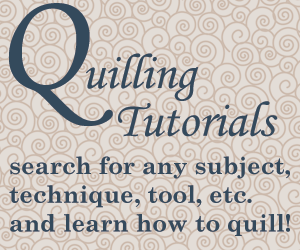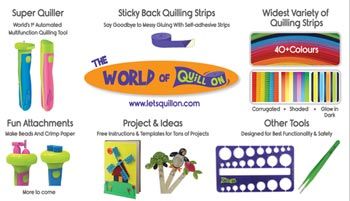Here is part 4 of my Mod Podge series! If you haven’t read the others in the series yet, here they are so you can catch up first:
Part 1 – The Different Finishes
Part 3 – Moderately Tightly Rolled Designs (Tight Flowers)
Over the past couple years I have gotten a lot of questions about Mod Podge, so I’m glad to finally be sharing some info and photos for those who want to use it with their paper quilling.
In the previous posts I have showed what all of the different finishes of Mod Podge look like on the completed pieces. But for today’s post I decided just to use the original matte. I had bought a Mod Podge Starter Pack with small bottles of 5 different finishes. A great idea if you are not sure you want to use Mod Podge or if you want to try different finishes before buying a big bottle of your favorite.
All of the Mod Podge finishes behaved the same, some were just more glossy than others. So today I am focusing on how to correctly use them on loose rolls. You know, the tricky ones! It can be so delicate and beautiful to make your quilled jewelry with loose rolls or coils, but it is NOT so easy to put sealant on them without getting them misshapen. But as you can see in this photo below, it is possible!

I have written one post already to show how to apply sealant so that your coils don’t open. Click here to read that post. I was using a thin sealant in that post, though, which is a bit different than a thick one. So hopefully this post will help those who are using thick sealants like Mod Podge.
The rule is still the same – use several THIN layers. I’ll show you exactly what a thin layer looks like! To apply a thin layer I dip a small paintbrush into the Mod Podge, dab the excess off on the edge of the bottle, and brush a VERY thin layer onto the flower as you can see in this photo below. As you can see, in some places you can’t even see the sealant at all, and in other places you can see it a tiny bit. This is what it should look like. Apply this amount, let it completely dry, flip it over and repeat on the other side. You’ll need to do this same thing again on both sides (so two or three THIN layers on each side) and then you can do a thicker layer where you dab your brush into the spaces to get the Mod Podge everywhere. Don’t have too much Mod Podge on your brush when you do the last layer, though, or you’ll have clear gobs of Mod Podge dried inside your flower petals. If this happens you can use a toothpick or needle tool to wipe out the excess Mod Podge before it dries.
Below are two flowers that have too much Mod Podge on them. The left has somewhat too much, and the right has WAY too much. Mod Podge, like most sealants, is water based, and it soaks into the paper (though it doesn’t totally soak in the way a liquid sealer does). So if you put too much Mod Podge at once it will make the paper soggy which will open the coils. If you only put on a tiny bit like in the above photo it dries before the paper gets soggy, thereby keeping the coil in place!
To show you what happens when you dab on the amounts shown above, here are the three flowers. The one on the left already has several THIN layers. The other two are the same flowers as you see above, except that the Mod Podge has mostly dried. You can easily see how the coils are more open in the one with too much and way open in the one with way too much Mod Podge.
I’ll be writing one more last post about Mod Podge, summarizing all of the posts and letting you how I think Mod Podge rates as a sealant.
If you have any particular questions about Mod Podge, feel free to ask and I’ll do my best to answer!
View all of the Mod Podge posts here:
Part 1 – The Different Finishes
Part 3 – Moderately Tightly Rolled Designs (Tight Flowers)
Part 4 – Looser Rolled Designs (Loose Flowers)
Part 5 – Overview and Conclusion
Stick around and check out some of the other fun stuff on the blog!
Click here to view FREE paper quilling tutorials!
Click here to view paper quilling tips and tricks!
Click here to view a list of places to buy quilling supplies around the world!
Click here to view some of my own quilling projects, with tips so you can make your own if you’d like!
*All products and supplies in this post I purchased on my own.
*This post contains some affiliate links. If you purchase products through the affiliate links I get a small percentage (at no extra cost to you!). I only link to products that I believe in and/or love to use myself. Thank you for supporting my blog!




























Thank you so much for this entire blog! I’ve spent all day trading all the posts since I just received a Quilling starter kit for my 43rd birthday. 🙂 This particular one was super informative since Modge Podge is what I have available. I love that you showed the after effects of too much so I wouldn’t waste my paper by using thicker layers! Huge difference! Thanks again for keeping this blog going for so many years. You are truly gifted and appreciated. <3
Thank you so much for your kind comment! I hope you have lots of fun quilling! I’ve got many more tips and tutorials in the works, so make sure you subscribe to the blog or newsletter 🙂
Lol… Oops!! Reading all your posts, not trading them. 😉 Silly auto-correct. 🙂
I have tried Mod Podge, and found that it makes my loose coils unwind, so I end up with a hole rather than the spiral. Also, it is rubbery and bends. I have had much better luck using clear nail polish on loose coils, and then I dip the whole thing in Future floor polish. The nail polish helps the loose elements hold their shape in the Future. Once the Future floor polish is dry it’s rock hard and waterproof.
Hi Janet! Thanks for your comment, I’m sure it will help people! Yes, you have to be so so careful when using mod dodge to make it not unwind. You have to put on just a tiny bit at a time and let it dry, then later do a full coating. This is pretty much the case with all water based sealants. The upside is that they are made for crafts and usually hold their clear color for many many years. Clear nail polish, on the other hand, will turn yellow after some time, as it is not a product made to last. I’ve never tried any sort of floor polish, but I’m glad it works for you!